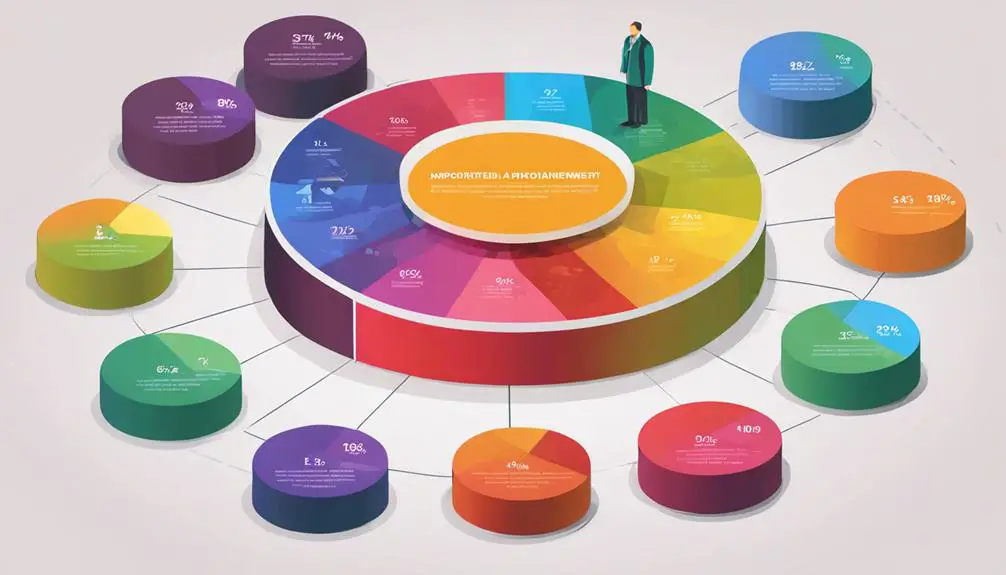The realm of statistics surrounding therapy unveils compelling insights into the prevalence and impact of mental health treatment across different segments of the population. With a substantial portion of American adults and teenagers engaging in therapy annually, and a significant percentage of working adults grappling with mental health challenges, the data underscores the significance of therapeutic interventions in our society.
These statistics not only shed light on the utilization rates but also hint at broader implications for mental health awareness and support systems. Such figures prompt a deeper exploration into the nuanced landscape of therapy and its evolving role in addressing mental well-being.
Key Takeaways
- Approximately 30% of American adults sought therapy since 2020.
- Common reasons for therapy include depression, anxiety, trauma, and relationship challenges.
- Therapy effectively addresses mental health issues like anxiety disorders, depression, and trauma.
- Therapy shows a high efficacy rate, benefiting around 75% of individuals.
Therapy Utilization Rates
Therapy utilization rates in the United States have shown significant increases, with approximately 30% of American adults seeking therapy since 2020. This surge in individuals seeking therapy services indicates a growing recognition of the importance of mental health care. In 2021 alone, about 42 million individuals in the U.S. received mental health treatment or counseling, highlighting the substantial demand for such services.
Moreover, it is noteworthy that approximately 17% of American teenagers undergo therapy annually. This statistic underscores the prevalence of mental health challenges among younger age groups and the necessity of providing adequate support and resources for this demographic. Additionally, each year, roughly 20% of working adults in the U.S. experience mental health issues, further emphasizing the need for accessible and effective therapy options in the workplace.
Furthermore, around 25% of adult women in the United States have received some form of mental health treatment in the past year. This finding indicates that a significant portion of the female population recognizes the value of therapy in addressing mental health concerns.
Reasons for Seeking Therapy
The reasons for seeking therapy are varied and encompass common issues such as depression, anxiety, trauma, and relationship challenges.
Many individuals also seek therapy to address specific mental health concerns like panic attacks, phobias, and obsessive-compulsive disorder.
Therapy serves as a valuable resource for those seeking emotional support, dealing with mental health issues, and striving for personal growth and self-improvement.
Common Therapy Reasons
Seeking therapy is a common practice for individuals experiencing anxiety, depression, relationship issues, grief, or trauma. Around 50% of all lifetime mental illnesses start by age 14, highlighting the significance of early interventions.
Besides these primary reasons, people also seek therapy for stress management, self-improvement, life transitions, and personal growth. Coping with major life changes, work-related stress, family issues, and emotional struggles are other common motivators for seeking therapy.
Recognizing symptoms and seeking therapy promptly can effectively address mental health concerns and enhance overall well-being. Therapy provides a supportive environment for individuals to work through their challenges, develop coping strategies, and gain valuable insights into themselves, leading to improved mental health outcomes.
Emotional Support Needs
Recognizing the emotional complexities individuals face, addressing their inner struggles is a pivotal aspect of fostering mental well-being and personal growth. Seeking therapy for emotional support needs is a common and beneficial practice. Here are four emotional support needs that drive individuals to therapy:
- Managing Stress: Therapy offers tools to manage stress effectively, reducing its impact on daily life.
- Coping with Anxiety: Therapists provide strategies to cope with anxiety, fostering a sense of calm and control.
- Dealing with Depression: Through therapy, individuals can address and overcome feelings of sadness and hopelessness.
- Healing from Trauma: Therapy aids in processing traumatic experiences, promoting healing and resilience.
Therapy serves as a valuable resource for individuals seeking to navigate and improve their emotional well-being.
Mental Health Issues
Amidst the myriad challenges individuals face in their mental well-being, common mental health issues often serve as compelling reasons prompting individuals to seek therapy for support and guidance. These issues include anxiety disorders, depression, trauma, and stress-related conditions.
Symptoms such as persistent sadness, overwhelming worry, panic attacks, and intrusive thoughts drive many to therapy. Relationship problems, grief, low self-esteem, and difficulties coping with life changes are also common triggers for seeking therapeutic help.
Therapy plays a crucial role in managing conditions like post-traumatic stress disorder (PTSD), phobias, and obsessive-compulsive disorder (OCD). By engaging in therapy, individuals can navigate emotional struggles, enhance coping mechanisms, increase self-awareness, and work towards improving their overall mental well-being.
Statistics on Depression Treatment
The statistics on depression treatment underscore the critical need for accessible and effective mental health interventions. Despite the prevalence of major depression among youth, nearly 60% do not receive the necessary mental health treatment. This alarming trend not only affects their current well-being but also increases their risk of developing cardiovascular or metabolic diseases by 40%.
Moreover, there has been a troubling 40% increase in persistent feelings of sadness among teenagers, pointing towards a concerning trajectory in mental health outcomes. Globally, over 300 million people are impacted by depression, making it one of the most common mental health conditions worldwide.
Effective treatment for depression is imperative, as it not only alleviates the individual's suffering but also has far-reaching implications on their physical health and overall quality of life. Addressing the gaps in depression treatment is crucial in safeguarding the well-being of individuals and promoting a healthier society.
Statistics on Anxiety Treatment
Statistics on anxiety treatment reveal the significant impact of anxiety disorders on a large portion of the population. With around 20% of working adults experiencing anxiety, it is evident that effective therapy for anxiety is crucial.
Understanding anxiety prevalence rates and the efficacy of various therapies can shed light on the importance of seeking help and support for this common mental health concern.
Anxiety Prevalence Rates
Anxiety disorders impact approximately 40 million adults in the United States, making it the most prevalent mental health issue in the country. This widespread condition affects roughly 19% of adults in the US, with about 20% of working adults experiencing symptoms of anxiety.
The pervasive nature of anxiety is evident in the fact that it is one of the primary reasons individuals seek therapy, alongside depression. These statistics highlight the urgent need for effective interventions and support systems to address the significant burden of anxiety on individuals and society as a whole.
Understanding the high prevalence rates of anxiety underscores the importance of prioritizing mental health initiatives and destigmatizing seeking help for these conditions.
Efficacy of Therapies
Given the prevalence of anxiety disorders and the imperative to address their impact on individuals and society, exploring the effectiveness of various therapies in treating anxiety becomes paramount. Cognitive behavioral therapy (CBT) has shown significant efficacy, benefiting up to 75% of individuals with anxiety disorders.
Exposure therapy is another successful treatment, reducing symptoms and enhancing quality of life. Combining therapy with medication has been proven highly effective in managing anxiety, leading to improved outcomes.
Mindfulness-based therapies like mindfulness-based stress reduction (MBSR) have demonstrated reductions in anxiety levels and overall well-being enhancement. Additionally, group therapy offers a supportive environment for individuals to share experiences, learn coping strategies, and alleviate feelings of isolation.
These statistics underscore the effectiveness of diverse therapeutic approaches in treating anxiety.
Mental Health Therapy Effectiveness
Research has consistently demonstrated the efficacy of therapy in treating various mental health conditions, with approximately 75% of individuals benefiting from this form of treatment. Therapy, particularly cognitive behavioral therapy, has shown significant benefits in managing a range of mental health disorders. Studies have indicated that therapy not only helps in symptom management but also plays a crucial role in reducing the risk of suicide in at-risk individuals.
Moreover, evidence-based therapy provided during counseling sessions has been proven effective in helping individuals alleviate the symptoms associated with mental health disorders. The emergence of online therapy platforms has further enhanced access to evidence-based counseling, offering a convenient alternative to traditional in-person therapy. Online therapy has been shown to be just as effective as face-to-face therapy for many individuals, ensuring that individuals can receive the support they need in a manner that suits their preferences and lifestyle.
Therapist Demographics in the US
Therapist demographics in the United States reveal a predominantly white, female workforce, with significant underrepresentation of Black, Latinx, Asian, American Indian, and Alaska Native individuals in the field. Around 86% of therapists in the U.S. are white, while only 4% are Black, 5% are Latinx, and 5% are Asian. Moreover, less than 1% of therapists identify as American Indian or Alaska Native.
The therapy workforce is also predominantly female, with approximately 82% of therapists being women. The average age of therapists in the U.S. is around 42 years old. When it comes to educational qualifications, about 87% of therapists hold a master's degree, while 7% have a doctoral degree.
These statistics highlight the need for greater diversity and representation within the therapy profession to better meet the needs of a diverse population seeking mental health services.
Trends in Therapy and Mental Health
The landscape of therapy and mental health services is evolving, reflecting a notable increase in demand and utilization among diverse populations. This shift underscores the importance of addressing mental health concerns and highlights the following trends:
- Growing Demand: Approximately 30% of American adults sought therapy since 2020, demonstrating a rising trend in mental health treatment.
- Increased Utilization: In 2021, around 42 million individuals received mental health treatment or counseling, showcasing a significant uptick in the utilization of therapy services.
- Early Intervention: About 17% of American teenagers undergo therapy annually, emphasizing the need to address mental health issues early on.
- Workforce Challenges: Each year, roughly 20% of working adults experience mental health issues, emphasizing the prevalence of such challenges in the workplace.
These statistics emphasize the evolving landscape of therapy and mental health, urging for continued support and resources to meet the growing demand for mental health services.
Conclusion
In conclusion, the statistics on therapy utilization rates, reasons for seeking therapy, and treatment effectiveness highlight the importance of mental health therapy in addressing various issues.
Additionally, the prevalence of therapy among different demographics underscores the significance of therapy in promoting mental well-being.
As therapy continues to play a crucial role in mental health care, understanding these statistics can help in improving access to and quality of therapy services for individuals in need.








